I have a list (selected_key_ratios) containing 4 data frames ($nestle ; $unilever ; $pepsico ; $abf). Each data frame contains financial data of a company. All dataframes have the same row index and almost the same columns (only currency differ sometimes). Here is a screenshot of the list.
I'm trying to make a new list where each item would be a column of the dataframe, grouped by company. Here is a graphical exemple:
And so on for each column of the dataframes. I tried things with lapply for hours now but nothing produces the desired result.
Do you have any clues ? Thanks a lot !

